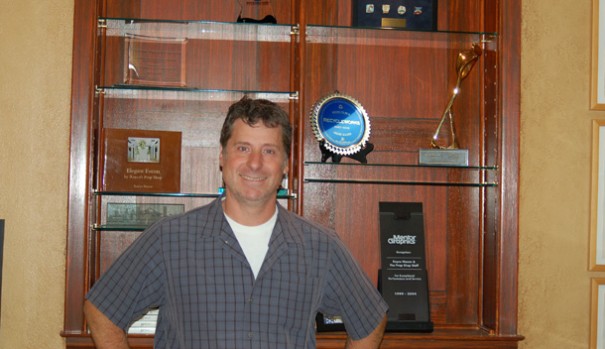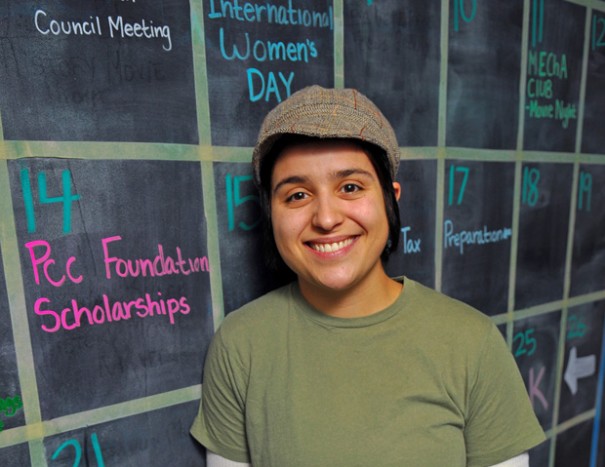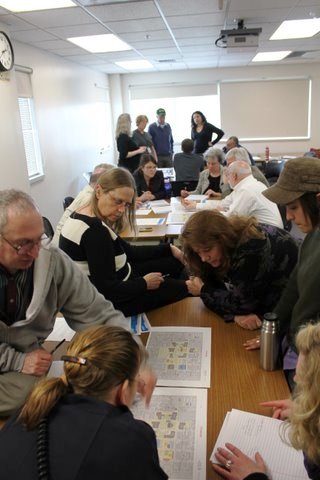This content was published: July 19, 2011. Phone numbers, email addresses, and other information may have changed.
Neighbors invest time and thought in the future of Cascade Campus
Photos and story by Gina Whitehill-Baziuk
Last fall, when Humboldt resident Isa Dean was approached by PCC to answer some questions about Cascade Campus and the surrounding neighborhood, she didn’t hesitate to share her point of view.
“I really enjoy being involved,” said Dean, who represents both her neighborhood and the Multnomah County Library on N. Killingsworth where she works. “What I enjoy is the opportunity to help shape the way the community is going to develop.”
Dean was one of more than sixty residents, business owners and nonprofit organizations that took part in a community assessment. The goal was to develop a comprehensive view of the needs and interests of the community regarding planned improvements for Cascade.

Royce Mason, owner of Royce’s Prop Shop on the northeast corner of Albina and Killingsworth, participated in the Bond Advisory Committee.
The reason? Cascade Campus is slated to receive $60 million of the $374 million, a bond approved by voters in 2008. At Cascade, the dollars will be used to create a new student center, increase classroom and lab space with a new academic building that will include a child care center, and develop a parking solution. To create the best possible solution for everyone affected, the college wanted input from the community.
PCC discovered that not only did the community members have an interest, they also had plenty to say.
“I expressed concerns,” said Royce Mason, president of local business Royce’s Prop Shop, Inc. and commercial property owner. “Since I was unhappy, they asked me to get involved.”
Dean and Mason – along with sixteen other members of the community – were invited to join a community Bond Advisory Committee (BAC) in November 2010. This committee was intended to complement the Strategic Work Group (SWG), which is made up of PCC faculty, staff and students.

Paula Barreto, former ASPCC President, served on both the Bond Advisory Committee and Stakeholder Work Group in 2010 and 2011 to help develop options for campus improvements. Photo by Vern Uyetake.
PCC alum Paula Barreto first joined the SWG as part of a student development program and was later asked to represent students on the BAC.
“Any time the administration wants to reach out and include students and really, really hear what students have to say, that’s important,” said Barreto, who graduated from PCC this spring and will pursue a landscape architecture degree at the University of Oregon this fall.
Other participants joined because of a deep interest in the future of the surrounding neighborhood.
“How PCC develops will have a big effect on the neighborhood and whether there is positive commercial development on Killingsworth. It’s a really important question to a neighborhood where my family’s been present for nine decades,” said Tom Markgraf, Piedmont resident and communications consultant.
Fifteen-year Humboldt resident and disability policy consultant Kerri Melda wanted more involvement than she had during the last campus build out. “I thought it would be fascinating to see how the whole process unfolded,” she said. “I wanted to make sure the community view was represented.”
Though a joint committee was considered, the ideal times for member availability conflicted. Hence, the idea was that both the BAC and SWG would go through a parallel process of planning. The SWG would primarily consider the needs of the PCC community, and the BAC would represent the needs of the surrounding neighborhood and business community, with each body highly informed of the others’ needs, desires, concerns and preferences.
They would compare their recommendations and eventually end up with a plan that incorporated everyone’s feedback.
But first, they had some work to do.

Members of the Strategic Work Group for Cascade Campus work on modelling exercises in May 2011. Photo by Grant Bennett.
“We’ve learned so much about zoning, resources, the bond measure, and the needs of the community and students,” said Mason. The challenge then became integrating the information and prioritizing needs, tasks that required a considerable amount of time and effort from both SWG and BAC members.
Cascade Dean of Instruction Scott Huff is a SWG member and a member of the Bond Executive Committee. He admits that, for him, the pace seemed slow at times. But, he added, “I love planning work of this sort. It takes me back to my roots as a civil engineer.”
Markgraf agreed and said, “I’ve been through a lot of planning processes. They aren’t usually fun and thoughtful. This has been fun and thoughtful.”
Issues that came up in the community assessment and continued to concern the two planning committees ranged from parking and neighborhood safety to campus design and community green space.
The two committees spent a lot of time discussing the possible locations for such things as a parking garage, a student center, childcare playground and retail space on Killingsworth. In April, they benefited from wider community response when the Bond Program held a series of six open houses where campus and community members could use 3-D tabletop models to experiment with different campus configurations.
SWG member Penny Thompson, who is the Student Learning Center Coordinator at Cascade Campus, believes that it’s critical to keep the big picture in mind, including the passage of time.
“It’s important to realize that the spaces we create need to be flexible because there’s no guarantee that anything will be in any one place forever,” said Thompson.
This spring all their hard work started to pay off. When the two groups came together to compare their plans, they found that they weren’t very far apart. In fact, Barreto said that discovering this common ground was the most surprising thing about the planning process.
“Our options were so similar,” said Barreto. “We’re pretty much right on track. We narrowed it down to the same necessities.”
“There was so much agreement between the different committees,” seconded Melda.
“It seemed to all come together in a plan,” said Mason.
In the end, two options were presented to the PCC Board at their July meeting, and the bond staff and THA Architecture will assess viability, cost, opportunities and constraints of each option over the summer.
Members of the BAC have expressed strong interest in continuing to meet next fall and into design, so they can follow through on their eight months of hard work. Across the board, members attest that those involved are devoted to making a better future for both the campus and the neighborhood.
Throughout the fall, the Bond Program will create opportunities to share information and collect feedback on the options. The BAC will reconvene in October to learn the results of the summer assessment work.
Barreto believes that it’s important that their recommendations are seriously considered and that “PCC doesn’t lose sight of what the BAC has done over the year.”
Or, as Dean put it, “It’s not resolved. You don’t know until it’s done.”
While Dean and others are still in a “wait-and-see” mode to determine the ultimate success of their participation in the planning process, they are hopeful for the future.
“PCC has the possibility of dramatically transforming lives and the quality of lives in this neighborhood, but it depends on the decisions that they make,” said Dean. “My hope is that the campus will become more a part of the community.”
“Killingsworth was a jewel when my grandparents were young. It should be a jewel again,” said Markgraf.
